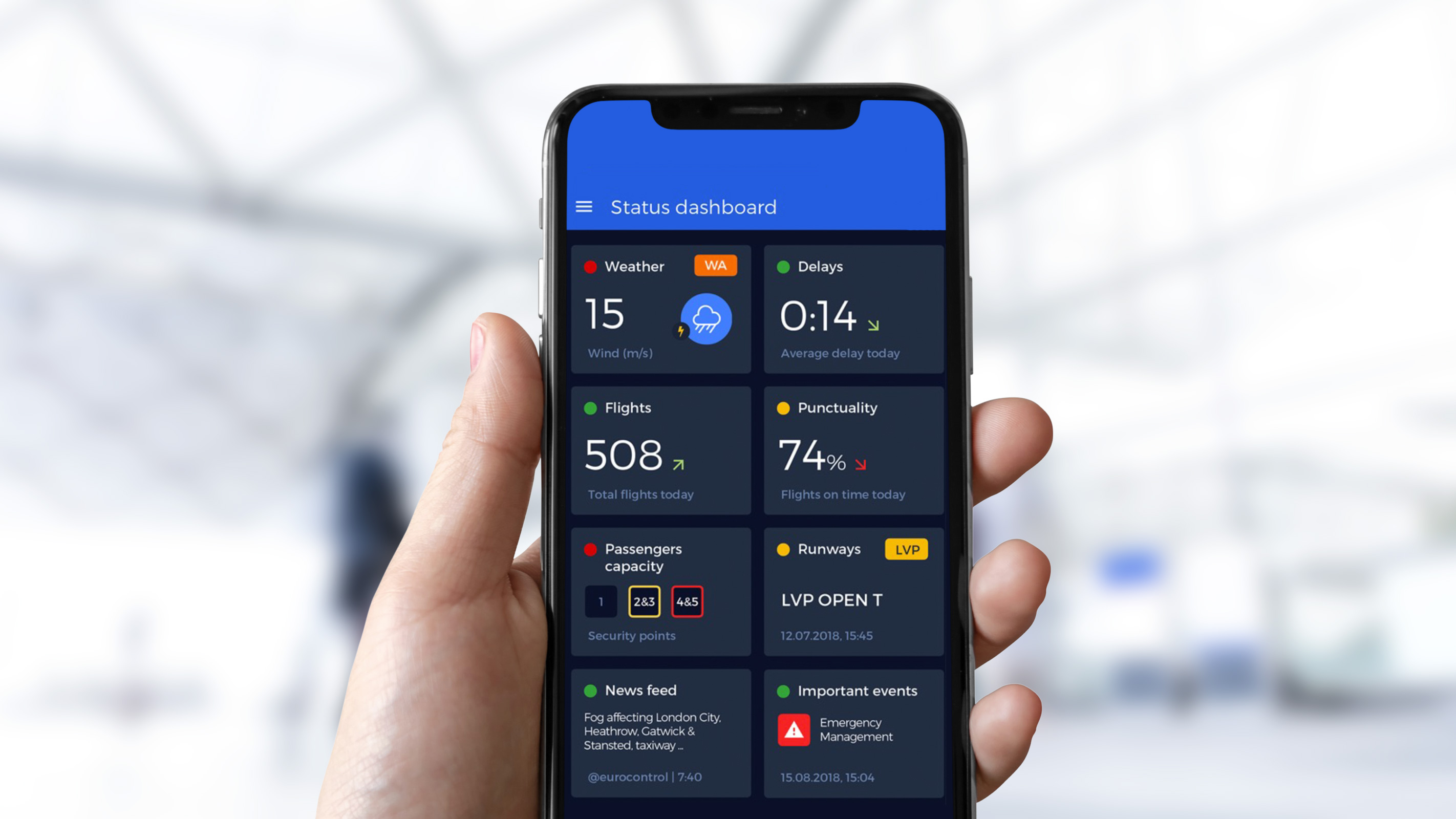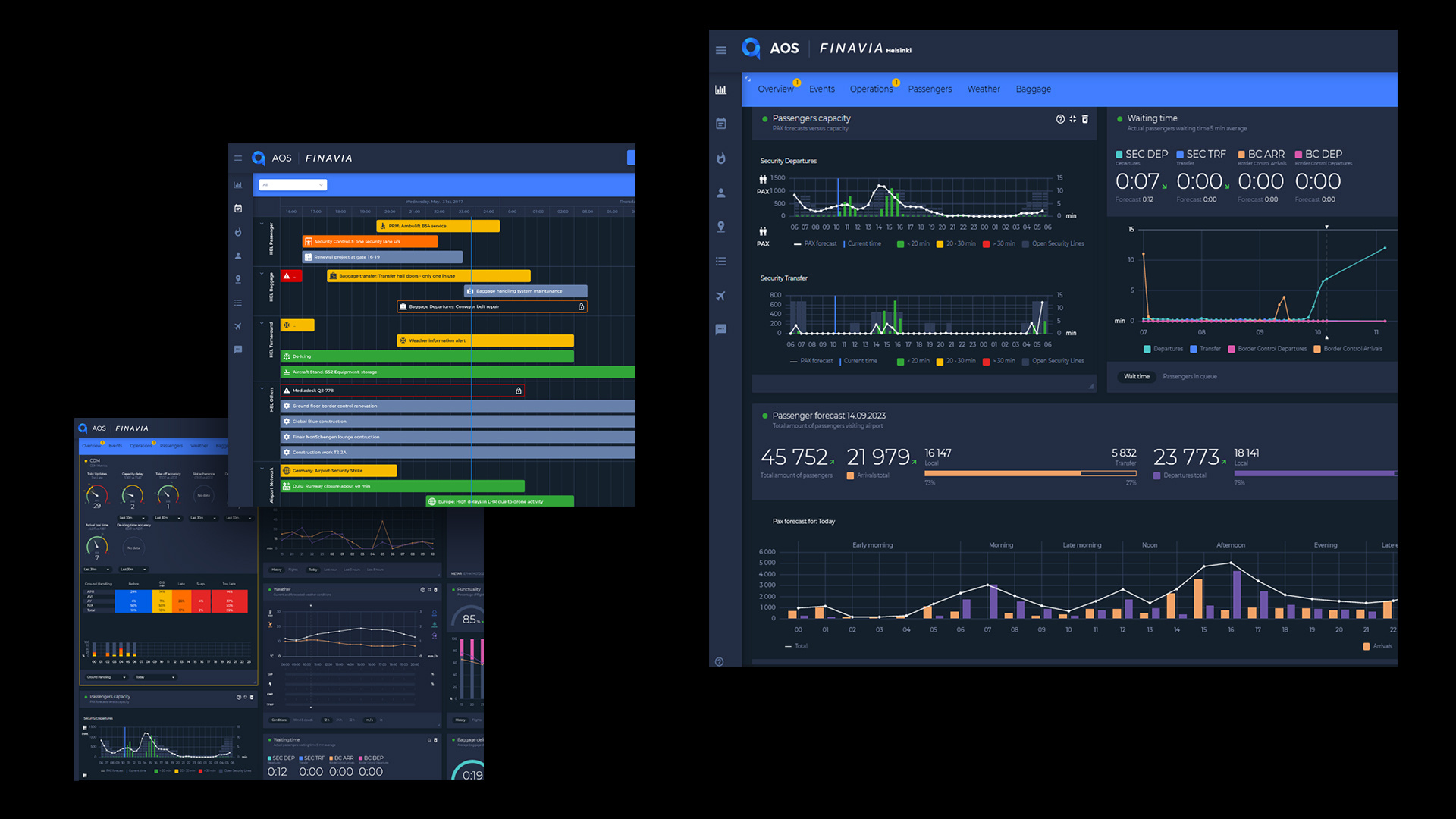Head of Traffic & Logistics
Helsinki
+358 40 715 5763
karoliina.tiuraniemi@siili.com


Case story
Situational awareness with unified data
Finavia
Executive summary
Before 2017, airport company Finavia relied mostly on manual communication methods like phone calls and emails to share operative information within the airport community. This led to inefficiencies, fragmented data, and a lack of real-time situational awareness, which significantly slowed decision-making—especially during disruptions.
To address this, Finavia partnered with Siili Solutions to develop the Airport Operational Status (AOS) system—a centralized digital solution improving operational predictability, communication, and collaboration. AOS also aligns with the EU’s upcoming Common Project 1 (CP1) regulation, which mandates enhanced airport efficiency by 2027.
Since its rollout, AOS has significantly improved both Finavia’s internal operations and the overall efficiency of airport communities across its network of 20 airports. Each year, AOS serves as the operative information platform for more than 2,500 events impacting Finavia airports.
Key Results
/
20-30min faster incident response time at scale. 2,500+ events and incidents managed annually
//
Readiness for upcoming EU regulation 2021/116 Common Project 1 (CP1)
///
Real-time operational data and communication for better decision-making and resource allocation
////
Improved situational awareness with centralized data for network of 20 airports and over 6,000+ active users across airlines, ground handlers, authorities, and other teams
/////
Reduced flight delays and higher passenger satisfaction scores
//////
Significant annual savings from streamlined workflows and processes

About the client
Finavia, the Finnish airport company, owns and develops 20 airports across the country, including Helsinki Airport. In 2024, these airports served a total of 19.6 million passengers—16.3 million of whom travelled through Helsinki Airport alone.
At Helsinki Airport, the operational ecosystem includes around 1,500 companies, authorities, and other stakeholders, all contributing to the airport community.
Helsinki Airport has been selected again in 2025 as the best airport in Europe in its size category.

The greatest benefit of AOS is that we have a single platform to unite all the airport data and processes. We can easily manage different kinds of incidents, disruptions but most important daily operations with one system.
Head of Airport Operations Center
Finavia
Challenge
Before 2017, the Airport Operations Center (APOC) had been managing all airport operations and incidents reactively over a fixed phone line or email. There was no real-time visibility for all the 12 airport operational units and processes—often co-operated with other stakeholders such as airlines, ground handlers, and authorities.
In summary, Finavia faced several challenges:
Scattered data
Business critical operational information was spread across disconnected systems, making it difficult to access, analyze, and act on in a timely manner. Response times were significantly slowed—both during routine operations and in times of disruption.
Complex stakeholder collaboration
With hundreds of organizations involved in daily airport operations, coordinating teams with diverse roles, responsibilities—and languages—was challenging. Ensuring the right information reached the right people in both Finnish and English was a constant operational hurdle.
Regulatory compliance
Upcoming EU regulations, including Common Project 1 (CP1), introduced further urgency for improving data sharing, transparency, and real-time communication.
Inefficient communication
Sharing updates and operational data depended heavily on manual processes, often resulting in delays, duplication of effort, and inconsistent delivery.
Increased pressure on performance
Rising passenger volumes and the demands of post-pandemic recovery put additional strain on operational efficiency, resource allocation, and service quality.

Solution
Finavia needed a system that could integrate data, enable real-time communication, and support decision-making. The AOS system was developed as a solution, providing real-time situational awareness, incident management, and enabling better collaboration.
Airport staff with the information they need, right at their fingertips with intuitive user interface, for smoother and more effective operations.
Mobile app
AOS mobile app provides instant notifications and alerts, ensuring that all stakeholders and users (Finavia staff, airlines, GH, authorities, commercial stakeholders) stay updated on critical information wherever they are.
The AOS mobile app offers a familiar, intuitive user experience with in-pocket notifications, full access to flight details, fault reporting, and direct links to airport contacts. Users can feed data into the operations center and tailor their notification preferences to receive only the most relevant updates—anytime, anywhere.

Operational dashboards
The AOS system provides a comprehensive, real-time overview of key operational data in a single, centralized platform. It brings together information on weather, passenger and baggage processes, turnaround activities, AODB flight data, events, tasks, resources, public transportation, maps, and alert data such as ATC alerts or evacuation notices—ensuring decision-makers have everything they need at a glance.
Data-Driven Operational Support
AOS transforms complex data into clear, actionable insights to support real-time decision-making.
The system brings together analyzed KPIs, recommended actions, forecasts, flight data, alerts, incident reports, and an interactive map view—all in one place. Automated emergency management ensures quick, informed responses when it matters most.
Incident management
AOS empowers Finavia to manage incidents swiftly and effectively through features like real time event creation and monitoring the operation status, secure handling of private events, built-in messaging, digital checklists, message templates, and predefined user groups.
It also enables continuous improvement: operators can log actions and create new checklists on the fly during emerging incidents—ensuring that future cases are supported by ready-made, experience-based instructions.
Messaging to predefined user groups
AOS supports targeted messaging and real-time status sharing that supports operative decisions. The app uses predefined user groups, enabling fast, role-specific communication during both routine and crisis situations.
Messages can be directed to specific stakeholders—such as ground handlers or emergency services—and scaled up when needed to reach the entire airport community. This ensures the right people receive the right information at the right time.

During disruptions we have now many ways to share the information with a community, and really make sure that the people get the information
Head of Airport Operations Center
Finavia
Impact
Since its rollout, AOS has significantly improved both Finavia’s internal operations and the overall efficiency of airport communities across its network of airports.
AOS has created a work environment that supports the needs of all stakeholders—from airlines and ground handlers to authorities and commercial partners. The system has also delivered measurable financial and operational benefits:
Faster response and scalable operations
AOS enables faster incident response—up to 20–30 minutes quicker—across the entire Finavia network. With over 2,500 events and incidents managed annually, the system ensures smooth coordination at scale.
Improved situational awareness
AOS offers a shared view of critical airport operations across 20 airports and connects a community of 6,000+ active users, including airlines, ground handlers, authorities, and commercial stakeholders—all on one unified platform.
Regulatory readiness
The platform supports compliance with upcoming EU aviation regulation 2021/116 Common Project 1 (CP1), by enabling transparent, real-time communication and process documentation.
Elevated passenger experience
With streamlined processes and faster recovery from disruptions, AOS contributes to reduced flight delays and supports higher passenger satisfaction scores, reinforcing Finavia’s service excellence.
Smarter decision-making
By providing real-time operational data and centralized communication tools, AOS empowers teams to make faster, more informed decisions, improving resource allocation and operational control.
Significant cost savings
Automation and streamlined workflows bring significant annual savings, reducing manual workload and enabling Finavia to optimize performance with fewer resources.
Situational awareness beyond aviation
The success of the AOS project demonstrates its value far beyond aviation. Its core capabilities—shared situational awareness, rapid information distribution, and centralized collaboration—can be adapted to other complex operational environments, such as hospitals, logistics companies, or maritime operations.
Key industries where AOS can deliver significant value include:

Healthcare
AOS’s real-time data integration and incident management capabilities can streamline hospital workflows, improving patient flow, bed utilization, and resource allocation.
Scenario-based planning and real-time communication tools in AOS can be adapted for emergency responses in healthcare facilities.

Maritime & port operations
AOS’s ability to manage large-scale operations and diverse stakeholders is directly transferable to managing various port activities, including vessel tracking and cargo handling.
Integration with maritime data systems can reduce turnaround times and resource utilization The scalability and adaptability of AOS make it a robust solution for any complex operational environment requiring real-time data integration, predictive insights, and efficient collaboration.

Logistics & supply chains
AOS can unify logistics operations by integrating data across supply chain nodes, providing real-time visibility of goods, resources, and processes.
Machine learning models can forecast disruptions, optimize inventory levels, and enhance delivery reliability.
Finavia AOS project
Technologies and methods
-
- Service Design
- User Research
- UX/UI
- Cloud Management
- Software Development
-
- ES6
- Typescript
- React
- React Native
- Redux
- Redux Saga
- Firebase
- Google Cloud
- React / React Native
-
- Agile development for iterative improvements.
- Human-centered design for intuitive interfaces.
- Continuous delivery for seamless updates.
Contact
Let’s talk
Turn complexity to clarity. Explore how situational awareness can transform your operations.
-
→Karoliina Tiuraniemi
